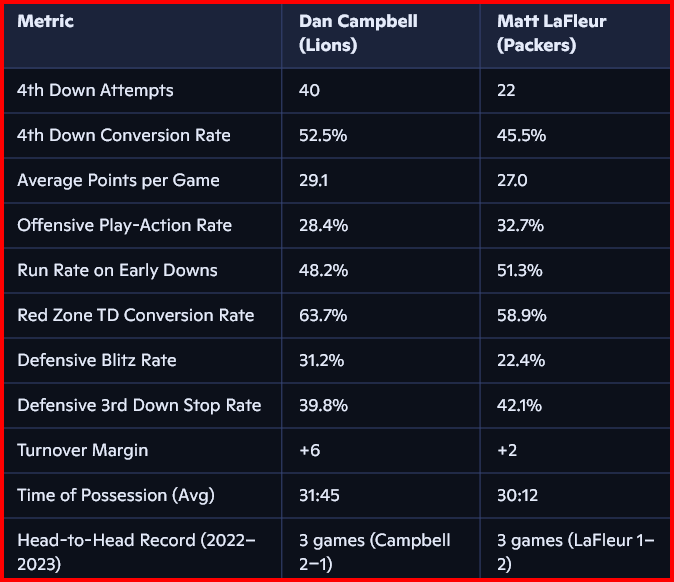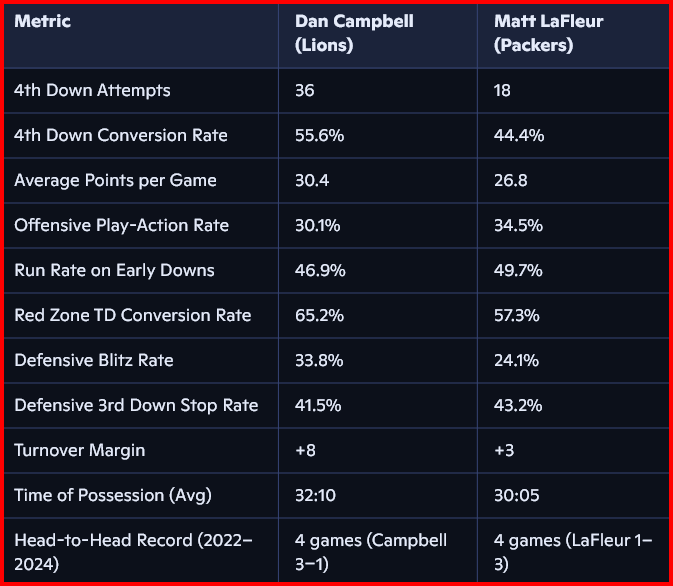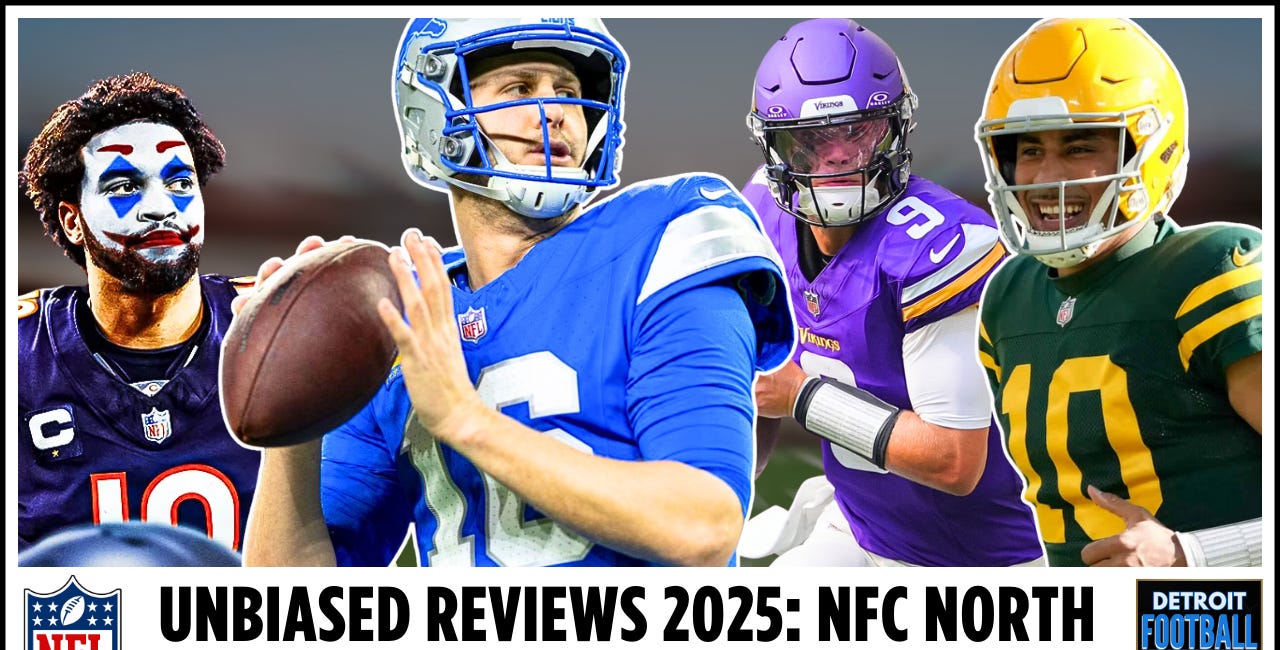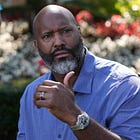NFL Week 1 Deep Dive: The Coaching Strategy Breakdown For Matt LaFleur
Keys To The Game Kicks Off With A Deep Dive-History Is A Great Place To Start When Trying To Understand A Rivalry Through Coaching Tendencies
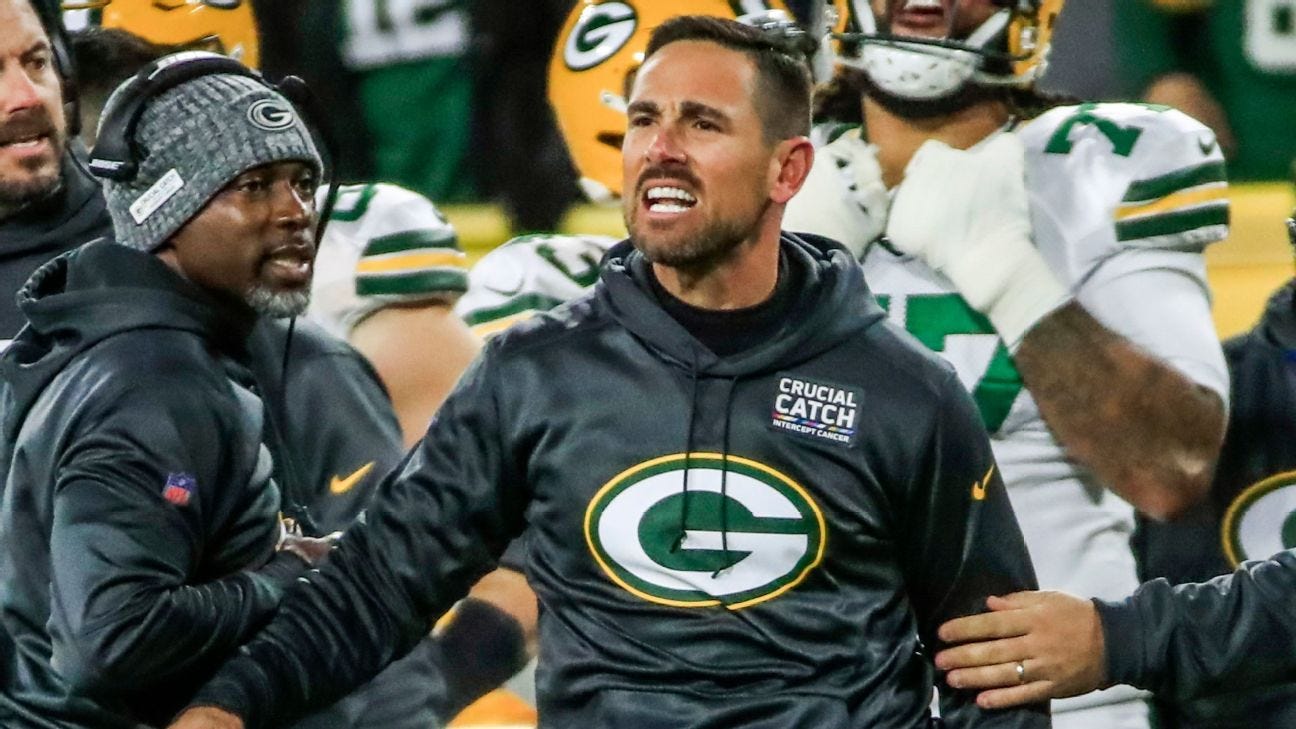
Matt LaFleur enters the 2025 season with a reputation for precision and poise. While Dan Campbell commands headlines with his aggressive fourth-down calls, LaFleur operates with a quieter intensity—his playbook built on motion, misdirection, and rhythm. Since taking over in Green Bay, he’s led the Packers to multiple playoff appearances and crafted one of the league’s most efficient offenses, even amid roster turnover and quarterback transitions.
LaFleur’s system thrives on balance: zone runs that set up play-action, layered route concepts that stretch defenses horizontally, and a commitment to staying on schedule. But against Detroit, that balance has been disrupted. The Lions have won three straight matchups, often by collapsing the pocket and forcing LaFleur’s offense off script. This week, with Jordan Love under center and a retooled receiver corps, LaFleur faces a familiar challenge—how to outmaneuver a defense that’s built to break rhythm and punish hesitation.
As Green Bay prepares to host Detroit, LaFleur’s strategic identity will be tested. Will he lean into tempo and RPOs to neutralize Detroit’s front? Or will he trust his run game and protection schemes to buy time for deeper shots? Either way, this game offers a revealing look at how LaFleur adapts under pressure—and whether his methodical style can finally crack Campbell’s aggressive blueprint.
You Can Read The Dan Campbell Version Here
Coaching Tendencies and Risk Tolerance
Matt LaFleur—who, until recently, was the NFC North’s most experienced coach—made his mark with offensive creativity, game management, and a historically high win percentage in his early years (13-3 records in both 2019 and 2020, 67-33 overall through 2024). He built his Packers teams around tailored variations of the West Coast offense, initially under Aaron Rodgers and, more recently, transitioning into the Jordan Love era.
Early in his tenure, LaFleur was seen as “quietly aggressive”, particularly when analytics pointed toward risky decisions—though never quite as swashbuckling as his counterpart in Detroit.
However, recent analysis reveals a shift: LaFleur’s 2024 campaign was marked by a distinct conservative turn, with a notable aversion to fourth-down aggression. He attempted a fourth-down conversion in only one out of nine “go or kick” situations prior to Week 15, a marked regression from previous seasons where he’d been praised for following the numbers.
Observers suggest several reasons for this change—transitioning leadership post-Rodgers, a younger and more error-prone roster, or scars from prior high-stakes failures (notably the NFC Championship fourth-and-goal field goal at the end of 2020).
LaFleur himself has admitted to “overthinking” risk at times and strives to find the right balance between aggression and pragmatism. As the offensive focus has tilted more toward the run, LaFleur seems to prefer hedging against mistakes, especially with a developing quarterback in Love.
Offensive Play-Calling Style
Green Bay’s offense under LaFleur is rooted in Shanahan-McVay tree principles—wide-zone running game, play-action passes, and “the illusion of complexity” built from motion and flexible personnel groupings. Notably, the Packers employ pre-snap motion on 43% of plays, third-most in the NFL, to manipulate and diagnose defensive structures.
In 2024, LaFleur leaned harder than ever on the run game, running on 50.7% of plays—the third-highest rate in the league—after signing bell-cow Josh Jacobs, who posted 1,329 rushing yards and 15 TDs. The offensive line investment (with multiple high draft picks) and roster moves indicate LaFleur’s prioritization of ball control and sustaining drives over explosive, risky aerial assaults.
Still, his attack remains capable of vertical shots and “feast or famine” sequences. LaFleur’s Packers ranked among the league leaders in explosive pass plays. However, this aggressiveness from quarterback Jordan Love has been a double-edged sword—yielding both highlight plays and costly turnovers, including a memorable pick-six against the Rams in 2024 when Love forced a deep throw from his own end zone.
LaFleur’s adaptability is undergirded by a willingness to mix up personnel, use bunch formations and play-action, and adjust run-pass tendencies according to opponent defensive looks. He's received high praise from analysts and peer coaches for making his run designs difficult to predict, “throwing off usual tells for defensive front sevens” by changing mesh points and integrating misdirection.
Defensive Play-Calling Style
With LaFleur serving as a CEO-style head coach, defensive schemes have toggled over the years depending on coordinator and personnel. For 2025, high-profile changes include hiring DeMarcus Covington (from New England) as defensive line/run game coordinator—a move expected to bolster a unit that’s often played bend-but-don’t-break football.
Historically, Green Bay’s defense under LaFleur has emphasized coverage disguises, moderate blitz rates (47.1% in 2023), and prioritizes limiting explosive plays over all-out aggression. In 2024, the arrival of Micah Parsons via blockbuster trade signals intent for more edge disruption, and the addition of first-round cornerbacks could indicate more press-man looks and possible uptick in blitzing as the new season opens.
Importantly, LaFleur’s defensive strategy is very much collaborative: he prizes input from staff and promotes adaptivity mid-game, as demonstrated by backfield rotation, schematic pivots, and increased in-game communication.
Fourth-Down Decision-Making
LaFleur’s approach to fourth downs has fluctuated over his tenure. Early on, he gained a reputation for following analytics when it suited Green Bay’s personnel, but rarely went “all-in” compared to Campbell’s relentless approach.
Notably, his infamous decision to kick a field goal down eight points in the 2020 NFC Championship (rather than trust Aaron Rodgers on fourth-and-goal) became a symbol for over-cautiousness when the moment demanded boldness. Analytics models estimated this cost the Packers a 3% game-winning chance—a significant blunder in such context.
In 2024, LaFleur became even more risk-averse, attempting fourth downs in “go” situations at just 11% frequency, often opting instead to try to draw an offside penalty or burn a timeout. The Packers left points on the board in games like the victory over Seattle, where clock management and a lack of aggression were criticized even as wins mounted.
This “meekness” is a far cry from his “all gas, no brakes” days, and analysts now question whether a conservative LaFleur can keep up with more aggressive rivals, particularly in high-leverage divisional matchups like those against Detroit.
In-Game Adjustments
If there’s one area in which LaFleur excels, it’s in-game flexibility and tactical adjustment. He is known for strong sideline communication with his quarterbacks (first Rodgers, now Love), leveraging static coverage snapshots on tablets to identify leverage or alignment mismatches in real time, and implementing route or formation changes drive to drive.
For example, in a 2024 game against the Cardinals, LaFleur and Love identified a defensive alignment on the sideline and promptly designed a route adjustment that went for a 44-yard touchdown when the opportunity presented later in the half. This illustrates LaFleur’s “learning loop”—he trusts input from quarterback and staff and is quick to implement real-time adjustments when data and observation support the change.
LaFleur’s post-halftime adaptations have also received praise. The Packers’ second-half performances frequently display better synchronicity and offensive efficiency, suggesting a strong halftime adjustment culture. Against the Vikings in Week 11, LaFleur described the team as “most in sync we have been all season” in the second half.
Strategic Evolution: 2023–2025
LaFleur’s post-Rodgers era is one of cultural redefinition and tactical recalibration. Losing a Hall of Fame quarterback forced a more cautious, run-first approach while Green Bay broke in Jordan Love. Leadership voids required LaFleur to be more vocal and directly responsible for player confidence and buy-in.
Offensive expectations are shifting; as Love matures, LaFleur faces the challenge of balancing big-play risk with ball security. This has produced some “feast or famine” offensive sequences, and a corresponding search for the right mix of aggression and prudence.
The organizational philosophy remains adaptable—roster additions during the offseason, such as Parsons on defense and top-100 receiver picks on offense, signal a willingness to make bold moves to update the team’s margin for error and competitive ceiling. LaFleur himself has pushed for a move from “almost there” to “over the top” in playoff situations—acknowledging, “When you have opportunities, you’ve got to make the plays, make the calls, and put the guys in the right spot… some playoff games come down to a handful of plays, one possession, you’ve got to make the play”.
Head-to-Head vs. Campbell’s Lions, 2023–2024
LaFleur’s Packers have struggled to solve the Lions in recent head-to-heads, losing six of the last seven and three consecutive at home. Campbell’s fourth-down conversion aggression and the Lions’ ability to sustain offensive drives have exploited LaFleur’s relative conservatism.
Despite some close games, the trend is clear: when the Packers have failed to generate explosive plays or get stops in high-leverage moments, Campbell’s play-to-win approach has trumped LaFleur’s play-not-to-lose strategy.
Analyst Perspectives and Insights
LaFleur is lauded for his offensive schemes and adaptability to personnel, especially his mastery of Shanahan/McVay concepts: “plays that start off looking the same but are different, plays that play off of plays... lessens predictability and keeps a defense off balance”.
Ted Nguyen’s survey of defensive coordinators places LaFleur among the best offensive playcallers, especially for “run-game creativity” and manipulating defenses with motion (43% usage rate).
Yet criticism has mounted regarding LaFleur’s fourth-down conservatism in 2024, with coverage from Zone Coverage noting that “after being among the most aggressive in his first few seasons, he regressed to one of the most conservative... sometimes burning timeouts in the process”. Wisconsin Sports Today’s analysis uses Ben Baldwin’s decision model to demonstrate that LaFleur’s tendency to “play it safe” stands in contrast to when “analytics call for aggression”.
From a leadership perspective, analysts such as Spencer Adonis at Packernet and Freddie Boston at LombardiAve highlight LaFleur’s strengths as a “culture builder” and “steadying voice,” especially valuable in the post-Rodgers transition. Questions remain, though, about whether this steadiness can overcome the self-imposed ceiling of risk aversion in big moments.
What to Expect in Week 1: Tactical Implications
Anticipate another clash of aggressive vs. pragmatic philosophies—both coaches bring particular areas of strength and evolving tendencies into the 2025 opener.
For Green Bay and LaFleur:
A gradually more balanced approach on offense, with an increased willingness (compared to late last year) to mix in vertical passing, thanks to the reintegration of Jordan Love and new weapons. Yet, the core DNA remains run-heavy, trusting Josh Jacobs as a bellcow.
On defense, with new leadership and the debut of Micah Parsons, expect early experimentation—potentially more blitzing, more disguised coverages, and steps to avoid being “methodically bled” by Campbell’s offense.
Fourth-down choices will be critical; if LaFleur maintains recent conservatism, it risks ceding the psychological edge and time-of-possession battle to Detroit. Analyst consensus is that Green Bay must rediscover LaFleur’s previously favorable approach—embracing analytics rather than retreating from risk in pivotal moments.
Game management and halftime adjustments could be decisive. If one coach can “steal” a possession via successful aggression or sudden tactical shift (e.g., load up the box or unleash an early deep shot), it could be a momentum-defining moment.
Rock’s Take
Matt LaFleur’s coaching style is rooted in balance, rhythm, and adaptability. His offenses are built on motion-heavy schemes, play-action deception, and a commitment to the run game—even when trailing. While not as outwardly aggressive as Dan Campbell, LaFleur’s approach is quietly calculated, often using tempo and formation shifts to create mismatches and isolate defenders.
This week’s matchup against Detroit presents a unique challenge. LaFleur has struggled to solve Campbell’s defense in recent meetings, particularly when the Lions collapse the pocket and disrupt timing routes. With Jordan Love still developing and Christian Watson sidelined, LaFleur may lean heavily on RPOs and quick-game concepts to neutralize Detroit’s pass rush. Expect a heavy dose of Micah Parsons off the edge and creative usage of rookie WR Matthew Golden to stretch the field horizontally.
Defensively, LaFleur’s staff will need to contain Jahmyr Gibbs and David Montgomery without overcommitting. The Lions’ ability to generate explosive plays off play-action makes discipline in the second level critical. If Green Bay can force third-and-long situations and limit Campbell’s fourth-down aggression, LaFleur’s methodical style could grind out a win.
Ultimately, LaFleur’s success this week hinges on execution and composure. He’s not a coach who wins with bravado—he wins with precision. Against a Lions team that thrives on chaos and momentum, LaFleur must keep the game within structure and avoid the kind of shootout that favors Campbell’s aggressive instincts.
If Green Bay can stay on schedule and protect Jordan Love, LaFleur’s system has the tools to win. But if the Lions disrupt that rhythm early, LaFleur may need to evolve his approach mid-game—a test that could define his season
Key Strategic Metrics (2023 Season)
Key Strategic Metrics (2024 Season)
All coaching metrics and team statistics were compiled using publicly available data from Pro Football Reference, ESPN Stats & Info, NFL Next Gen Stats, StatMuse, and Sharp Football Analysis. Metrics reflect regular season performance unless otherwise noted.
Join The Detroit Football Journal Daily Podcasts Below
STAY IN THE GAME WITH DETROIT FOOTBALL JOURNAL
The NFC North's Top Ranked Quarterback Is Once Again Jared Goff - It's Not Close
Every season Rocked On Sports Media performs an unbiased review for all positional groups within the NFC North. Grading, analyzing and ranking each positional group from one (1) being the best, and four (4) being the worst.



